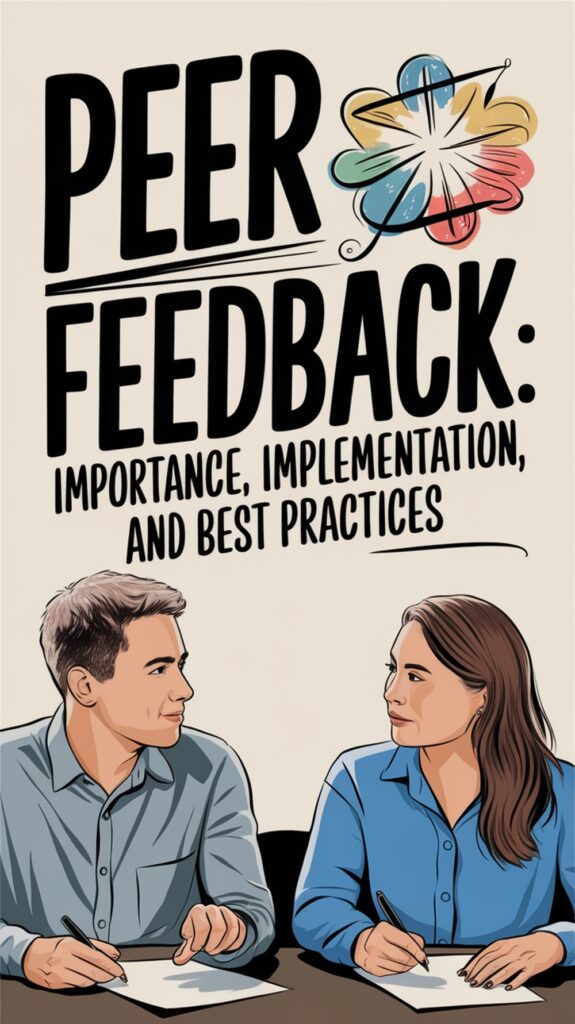Peer feedback is receiving guidance and helpful suggestions from people that you collaborate with, usually in the classroom or workplace. I’ve found this practice valuable in helping identify what’s working and what needs to be adjusted.
Increasing peer feedback is a key tactic employed by many teams to increase skill while fostering trust. Open conversations among colleagues help facilitate development, address misunderstandings, and lead to achievable objectives.
In this article, I’ll share some practical, “real-world” approaches you can use that take advantage of peer feedback.
Jump To Section
Peer Feedback: What is It?

Peer feedback should not be an afterthought, or a simple checkbox. It’s an authentic practice in which colleagues offer sincere, constructive feedback on each other’s work. Many people are familiar with peer feedback from their school days, where students would read and provide written comments on a peer classmate’s paper.
In the workplace, it goes deeper, supporting one another’s learning and growth. Rather than just receiving feedback from a superior, everyone receives feedback from their peers, who are in a position to evaluate their performance daily.
This kind of feedback goes by many names: peer evaluation, peer response, or peer critiquing. Whatever name you use, the concept is the same. People peer review each other’s stuff to figure out what’s effective and what just needs a small adjustment.
It’s not just a one-way street, either. True peer feedback is a dialogue, an exchange. Both parties speak candidly and get challenged to improve in ways that they wouldn’t on their own.
More Than Just “Reviews”
Peer feedback is less about the competition and more about the collaboration. Teams that utilize it effectively create a culture of constructive dialogue, not just at annual evaluations, but on a more frequent basis.
In my workplace, after every project, my team would get together. We reflect on what was successful and what was not. Continuing this discussion is critical in order for all of us to continue to learn.
This means that feedback is a mechanism for continuous improvement and not merely a grade of how well we did.
Why Peer Feedback Is a Game-Changer

In corporations and classrooms too, it truly is transformative. As employees and students develop the practice of giving and receiving feedback from their peers, an atmosphere of trust and vulnerability is developed.
People are able to be seen, heard and respected. This trust forms a strong foundation for each project. It’s not only about criticizing, it’s about encouraging one another.
1. Builds Stronger Team Bonds
When teammates open themselves up by sharing constructive critiques, it builds intimacy and trust. Honest, candid conversation results in greater transparency. People get to know each other’s working styles and idiosyncrasies.
2. Shines Light on Blind Spots
Peer feedback helps you to see what you can’t see yourself. With multiple people reviewing work, issues that might be hidden suddenly emerge. That translates to less surprise and more opportunity for development.
Truthful, equitable critique allows individuals to recognize and own their authentic power.
3. Sparks Real Personal Growth
Receiving peer feedback requires individuals to step outside their comfort zone and develop new skills. It takes the intimidation out of growth and makes it feel achievable.
When feedback is specific and positive, it allows learners to establish goals and monitor their progress towards them.
4. Creates a Better Work Vibe
An environment in which constructive feedback is shared openly and easily is an environment in which people choose to be. People appreciate recognition.
5. Drives Better Team Results
Peer feedback creates important connections to improved outcomes. That’s because teams are able to reach their goals more quickly and produce higher-quality work.
Different Forms of Feedback

Peer feedback can take many forms and may look very different in each group. The delivery and purpose of feedback are just as important as the content. It could be constructive in the sense of building up a teammate, correcting someone’s course on a task, or both. The setting, the purpose, and even the recipients alter its impact.
Quick Chats vs. Formal Sit-Downs
A quick chat in the hallway is usually more laid back and repairs a minor problem in short order. Verbal feedback allows individuals to ask questions or resolve points of confusion immediately.
Formal, structured sit-downs allow for thoughtful discussion but can be intimidating if trust is lacking. An appropriate blend aids teams in solving a variety of issues.
Feedback for Growth vs. Tasks
Some feedback is for growth, such as helping a teammate develop a new skill. Other feedback is more focused on the current task.
Both kinds are important. In equitable teams, everyone develops professionally and personally. It’s important to be intentional about the type of feedback you’re providing.
Named vs. Unnamed Comments
When feedback is named, it creates intimacy and trust, but it can be very painful. While anonymous feedback seems less intimidating, it often lacks context or comes off as harsh.
Ongoing Tips vs. Project Reviews
Timely, ongoing feedback allows people to make corrections on the fly. Project reviews, on the other hand, allow teams to critically reflect on their work and spot trends.
Both serve a purpose. Weekly, monthly, or quarterly regular check-ins identify small issues, but the project reviews provide the overall picture.
Set Up Your Peer Feedback System

Creating an effective peer feedback system requires more than just asking people to submit their comments. Develop a system that works toward your objectives and suits your team’s requirements. It needs to represent the culture you’d like to develop as well.
This section outlines the steps and considerations involved in making peer feedback a success, from preparation all the way through to implementation.
Define Your Program’s Aims
Begin with what you want to achieve with a peer feedback system, and let your team know. Your goals are to improve collaboration and help with conflict resolution. Setting your goals in simple terms sets the foundation for what everyone should be working toward with their sessions.
For example, you might say, “We want peer feedback to help everyone grow, learn new skills, and support each other as a team.” Link your feedback objectives to what is a priority for your cohort or organization. If your organization values creativity, tailor the feedback to help people improve on creative thinking.
If your firm is serious about service, ensure that comments include ways to better serve clients. I advise teams to remember these goals while conducting any feedback. This way, everyone’s on the same page with what the purpose of the entire exercise should be.
Pick Tools to Make It Easy
The tools you choose have a huge impact on whether your feedback system succeeds or fails. In our current environment, technology plays a key role. Online discussion forums, Google Docs, or other collaborative group tools allow everyone to see and share feedback from any location.
Check for intuitive navigation, easy login options, and responsive help if something goes awry. See if people need training on the tool before beginning your peer feedback process. Much easier to deal with that up front than have technology issues deflate your enthusiasm!
Build a Trusting Atmosphere
No one will take feedback seriously if they don’t have a trusting atmosphere. Build a trusting atmosphere. Begin by creating a safe environment. That starts with establishing ground rules that prioritize respect and kindness.
You may want to use something like the 5:1 rule, share five positive comments for every one critique. This goes a long way to ensuring the feedback is always positive, and being positive helps them be more open to knowing what they should improve on.
Decide on Feedback Cadence
Determine a rhythm, every week, every month, quarterly or following major projects. Don’t be afraid to adjust the timing if situations call for it. The key here is to ensure feedback occurs regularly enough to be impactful but not too often where it feels like a chore.
Lead by Example: Your Role
As the leader, you are the one that sets the tone. Lead by example to establish your peer feedback system. Get everyone on board, and lead by example with your own growth. Once others see that you value criticism, they will start doing so as well.
Handle Peer Feedback Roadblocks

Peer feedback is a great opportunity for teams to build skills and deepen their understanding, but it doesn’t always go off without a hitch. Roadblocks can arise, such as feedback that is overly general or emotional reactions. Addressing these roadblocks requires intentionality and some specialized knowledge.
When Feedback Stings
When feedback stings, it can hurt to receive sharp criticism. Often, even well-intentioned feedback feels harsh when it’s not delivered the right way. People might be feeling discouraged, even defensive. I’ve found that “I” statements, e.g., “I got lost on your point here”, take the personal edge off of feedback.
Making sure it’s about the work, not the person, is crucial. Reassure members that feedback is part of the process of improving, not an indication that they’ve failed.
Keep It Fair and Honest
Feedback should be fair and honest, but never cruel. Having real examples is crucial for getting the message across fairly. For instance, start with, “I loved your introduction, but I was really confused by this part.”
Also providing each peer the equal opportunity to provide feedback helps keep it fair and honest. When there’s a culture of kindness and inclusion, feedback becomes easier to both give and receive.
Feedback for Remote Workers
Working remotely introduces some additional variables. Tech tools, whether video calls, chats, or shared documents, allow for collaborative feedback even when physically separated. These ongoing touchpoints help ensure that everyone is aligned.
Focused, specific communication goes a long way to making remote colleagues feel involved and valued.
Navigate Diverse Work Styles
Each person has their own particular style of communication and collaboration. Some people appreciate a no-nonsense approach, while other people require a more gentle approach. A little flexibility can make a big difference.
Conclusion
Peer feedback is a powerful tool when used correctly. It allows people to learn quickly, correct mistakes, and identify blind spots. Helpful feedback can increase credibility and ignite authentic development.
Following the practices in this guide make feedback a constant habit, rather than an intimidating, once-a-year occurrence.
Ready to make a difference? Get out there and put some of the above advice to the test, and exchange candid feedback today. You may be amazed at how much you both develop.








